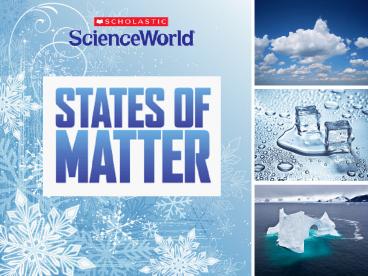States of Matter - PowerPoint PPT Presentation
1 / 12
Title:
States of Matter
Description:
WHAT DO YOU KNOW ABOUT STATES OF MATTER? What are the three commonly known states of matter? What is the gas, liquid and solid form of water? – PowerPoint PPT presentation
Number of Views:220
Avg rating:3.0/5.0
Title: States of Matter
1
(No Transcript)
2
WHAT DO YOU KNOW ABOUT STATES OF MATTER?
- What are the three commonly known states of
matter? - What is the gas, liquid and solid form of water?
- How does matter change state?
- Watch this animation on states of matter
(click Play Video)Animation States of
Matterhttp//teacher.scholastic.com/activities/st
udyjams/matter_states/Scholastic
3
WHAT ARE STATES OF MATTER?
Each of these states is also called a phase.
There are three common states of matter solid,
liquid, and gas.
States of matter are the physical forms a
substance can take.
4
THE THREE COMMON STATES OF MATTER
- Most substances, like water, can exist in all
three states.
5
SOLIDS
- Solids have a definite shape and volume, or
amount of space an object takes up.
- Solid particles vibrate in place but cannot move
from their position, which is why solids maintain
their rigid shape.
6
LIQUIDS
The particles that make up a liquid are spaced
farther apart and are held together by weaker
forces than solids.
- Liquids have a definite volume but not a definite
shape.
- Liquid particles move slightly, which allows
liquids to flow and take the shape of the
container they are in.
7
GASES
- Gases do not have a definite volume or shape.
- Gas particles move freely and will expand to fill
a container of any size or shape.
8
CHANGES OF STATE
- Matter can change from one state to another.
- Even though the physical form of the matter
changes, it remains the same substance.
- Changes of state occur when thermal energy (heat
energy) is absorbed or released by a substance.
9
WHAT ARE THE CHANGES OF STATE?
GAS
SOLID
LIQUID
10
HOW DOES MATTER CHANGE STATE?
- As heat increases, a substance changes from a
solid to a liquid, and finally to a gas.
- As heat decreases, a substance changes from a
gas to a liquid, and finally to a solid.
11
DISCUSSION QUESTIONS
- How does pressure and temperature affect the
state of water, carbon dioxide, and hydrogen? - On Earth, we typically see gases, liquids, and
solids. But is there a fourth state of matter?
- Use this interactive PBS Web site to find
outwww.pbs.org/wgbh/nova/zero/matt-flash.html. - Learn about a fourth state of matter at this Web
sitehttp//www.spaceweathercenter.org/amazing_pl
asmas/02/02.html
12
HANDS-ON SCIENCE(No Lab Required)
This demo explores melting points.
- Materials
- chocolate chips, candy-coated chocolates,
baggies, two mugs, water, thermometer
- Directions
- Place chocolate chips and candy-coated chocolate
in separate bags. - Place each bag of chocolate in a half-filled mug
of room-temperature water. - Your teacher will continue to increase the
temperature in each mug by adding boiling water
a little at a time. - As a class, monitor the temperature with a
thermometer until the chocolate starts to melt in
the bag.
Conclusion At what temperature does each type of
chocolate start to melt? Why do you think this is?































